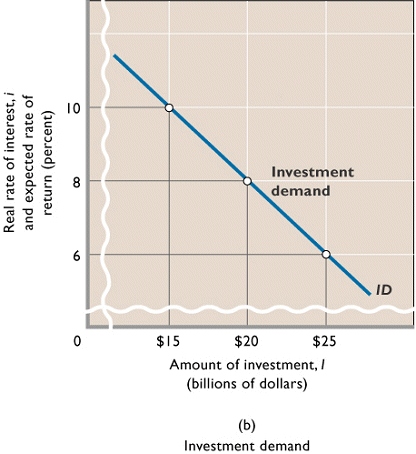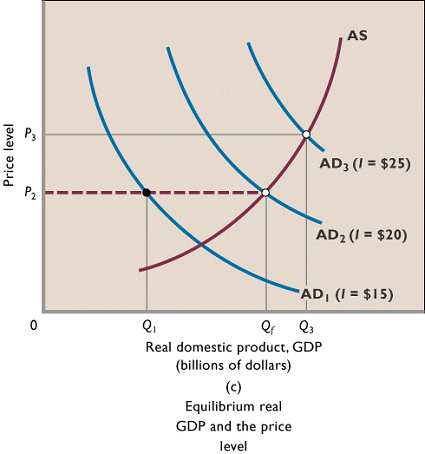Chapter 16
Monetary Policy
I. Introduction
A. Objectives of Monetary Policy
1. The fundamental objective of monetary policy is
to aid the economy in achieving full-employment output with
stable prices.
a. To do this, the Fed changes the nation’s
money supply.
b. To change money supply, the Fed manipulates size of
excess reserves held by banks (see chapter 15).
c. the Fed has four tools to do this
- Open Market Operations (OMO)
- changing the discount rate (DR)
- changing the required reserve ratio (RR)
- Term Auction Facility (similar to DR)
2. Monetary policy has a very powerful impact on the
economy, and the Chairman of the Fed’s Board of Governors,
Ben Bernanke currently, is sometimes called the second most
powerful person in the U.S.
B. Functions of The Federal Reserve System (Fed)
1. issue currency = Federal Reserve Notes
2. setting reserve requirements
3. lending money to banks and thrifts (the discount rate -DR-
is the interest rate banks are charged for borrowing from the
Fed
4. providing for check collection
3. acting as fiscal agent for the US government
4. supervising banks
5.
controlling
the money supply
C. REVIEW / PREVIEW: Monetary Policy: Keynesian Cause-Effect
Chain
1. A change in the Fed tools CAUSES
2. a change in excess reserves CAUSES
3. a change in the money supply CAUSES
4. a change in the interest rate CAUSES
5. a change in investment CAUSE
6. a change in aggregate demand CAUSES
7. a change in real GDP and a change in the price level
CAUSES
8. a change in unemployment and/or inflation

D. REVIEW /PREVIEW EXAMPLE:
If there is HIGH UNEMPLOYMENT in the economy, the
appropriate monetary policy policy and its effect illustrated on
our graphs would be:
|
FIRST: Chapters 15 and 16
|
SECOND: Chapter 14
|
THIRD: Chapter 10
|
FINALLY: Chapters 12 and 13
|
|
To increase the MS the fed must increase the ER of
banks.
Then banks could make more loans and create more
money.
To do this they would use an easy money
policy.
|
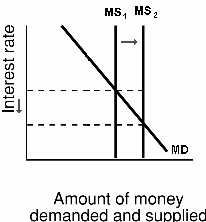
|

|
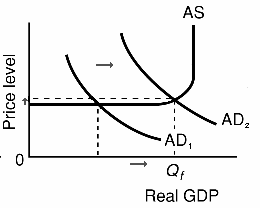
|
|
Easy Money Policy:
- buy securities on the open
market (OMO buy)
- lower the DR (
 DR)
DR)
- decrease the required
reserve ratio (
 RR) RR)
- Auction more
reserves
|
If the MS increases:
- Chapter 14
- MS shifts to the right
- interest rates decline
|
If the interest rates decline:
- the amount of investment increases
- there is a movement along the graph
- NOTE: the Investment demand graph does not shift
|
If investment increases:
- AD shifts to the right (increases)
- we have the chapter 13 multiplier effect
- real GDP increase and UE decreases
- the price level may increase causing more
inflation
|
|
|
|
|
|
MONETARY POLICY
II. Balance Sheet of the Fed
A. two major Assets
1. Securities which are federal government bonds
purchased by Fed, and
2. Loans to commercial banks (Note: again commercial
banks term is used even though the chapter analysis also
applies to other thrift institutions.)
B. three major Liabilities
1. Reserves of banks held as deposits at Federal
Reserve Banks,
2. U.S. Treasury deposits of tax receipts and borrowed
funds, and
3. Federal Reserve Notes outstanding, our paper
currency.

|
ASSETS
|
|
||
|
LIABILITIES
|
|
|
Securities
|
|
||
|
Reserves of banks
|
|
|
Loans to banks
|
|
||
|
Treasury deposits
|
|
|
other
|
|
||
|
Federal Res. Notes
|
|
|
|
|
||
|
other
|
|
|
|
|
|
|
|
III. The Tools of Monetary Policy
A. Three Tools of the Fed over the Money Supply
1. open market operations (OMO)
2. changing the reserve ratio (RR)
3. changing the discount rate (DR)
B. Open Market Operations
1. definition
Open-market operations refer to the Fed’s
buying and selling of government bonds.
2. buying securities
Buying securities will increase bank reserves and the money
supply
a. Example: Assume that the Fed buys a $1000
bond (security) from a commercial bank (RR = 20%)
1) then bank reserves go up by the value of the
securities sold to the Fed.
2) impact on balance sheets
|
Balance Sheet of the Fed
|
|
ASSETS
|
|
||
|
LIABILITIES
|
|
|
|
|
|
|
|
|
Securities
|
+ $1000
|
||
|
Reserves of banks
|
+ $1000
|
|
Loans to banks
|
|
||
|
Treasury deposits
|
|
|
other
|
|
||
|
Federal Res. Notes
|
|
|
|
|
||
|
other
|
|
|
|
|
|
|
|
|
|
Balance Sheet of the Banking
System
|
|
ASSETS
|
|
||
|
LIABILITIES
|
|
|
|
|
|
|
|
|
Reserves at Fed
|
+ $1000
|
||
|
Demand Deposits
|
|
|
Cash in vault
|
|
||
|
Other Deposits
|
|
|
Loans
|
|
||
|
Loans from Fed
|
|
|
Securities
|
- $1000
|
||
|
other
|
|
|
Other
|
|
||
|
|
|
|
3) When Fed buys bonds from
bankers, reserves rise and excess reserves rise by same
amount since no checkable deposit was created.
4) more excess reserves increases Bank's lending
ability -- remember when banks make loans they creat
money
5) Total change in the money supply:
 MS
= initial ER x money multiplier
MS
= initial ER x money multiplier
- money multiplier = 1 / RR = 1/.2 = 5
- SO:
 MS
= + $1000 x 5 = + $5000
MS
= + $1000 x 5 = + $5000
6) Textbook Figure 16.2
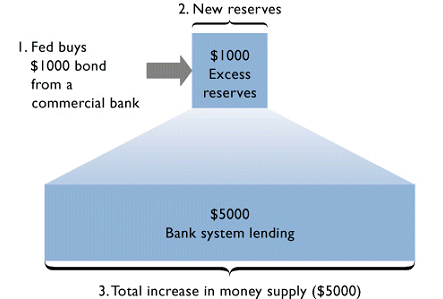
b. Example: Assume that the Fed buys a $1000
bond (security) from the general public (RR = 20%)
1) people receive checks from the Fed and then
deposit the checks at their bank. Bank customer's
deposits rise and therefore bank reserves rise by the
same amount. NOTE: this $1000 in new demand deposits is
NEW MONEY
2) impact on balance sheets
|
Balance Sheet of the Fed
|
|
ASSETS
|
|
||
|
LIABILITIES
|
|
|
|
|
|
|
|
|
Securities
|
+ $1000
|
||
|
Reserves of banks
|
+ $1000
|
|
Loans to banks
|
|
||
|
Treasury deposits
|
|
|
other
|
|
||
|
Federal Res. Notes
|
|
|
|
|
||
|
other
|
|
|
|
|
|
|
|
|
|
Balance Sheet of the Banking
System
|
|
ASSETS
|
|
||
|
LIABILITIES
|
|
|
|
|
|
|
|
|
Reserves at Fed
|
+ $1000
|
||
|
Demand Deposits
|
+ $ 1000
(this is new M1 money)
|
|
Cash in vault
|
|
||
|
Other Deposits
|
|
|
Loans
|
|
||
|
Loans from Fed
|
|
|
Securities
|
|
||
|
other
|
|
|
Other
|
|
||
|
|
|
|
3) Banks’ lending ability
rises with new excess reserves of $800. When Fed buys
from public, some of the new reserves are
required reserves for the
new checkable deposits.
4) Total change in the money supply:
 MS
= initial ER x money multiplier
MS
= initial ER x money multiplier
- money multiplier = 1 / RR = 1/.2 = 5
- SO:
 MS
= + $ 800 x 5 = + $ 4000 PLUS the initial $1000 of new
money created when the fed paid the public for the
gov't security = $ 5000
MS
= + $ 800 x 5 = + $ 4000 PLUS the initial $1000 of new
money created when the fed paid the public for the
gov't security = $ 5000
4) Textbook Figure 16.2
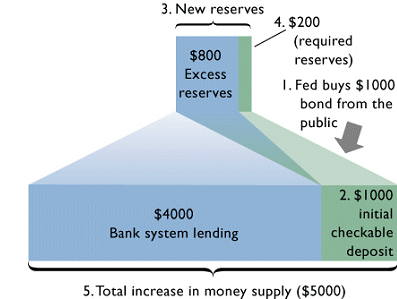
c. Conclusion:
When the Fed buys securities, bank reserves will
increase and the money supply potentially can rise by a
multiple of these reserves.
The Fed pays for the securities with new Excess
Resources (ER)
 MS
= initial ER x money multiplier
MS
= initial ER x money multiplier
OR
 MS
= value of securities bought x money
multiplier
MS
= value of securities bought x money
multiplier
The Fed would do this to fight unemployment (UE)
3. When the Fed sells securities:
a. the points above will be reversed.
b. Bank reserves will go down, and eventually the money
supply will go down by a multiple of the banks’
decrease in reserves.
c. they would do this to fight inflation (IN)
|
Three tools of the fed:
1. OMO
2. RR
3. DR
|
C. Changing the Reserve Ratio
1. raising the reserve ratio
a. Raising the reserve ratio increases required
reserves and shrinks excess reserves.
b. Any loss of excess reserves shrinks banks’
lending ability and, therefore, DECREASES the potential
money supply by a multiple amount of the change in excess
reserves.
2. lowering the reserve ratio
a. Lowering the reserve ratio decreases the
required reserves and expands excess reserves.
b. Gain in excess reserves increases banks’ lending
ability and, therefore, INCREASES the potential money supply
by a multiple amount of the increase in excess reserves.
3. EXAMPLE: What happens if the fed lowers the RR from
20% to 10% ?
Initially assume
- RR = 20%
- and the banking system has the following balance
sheet
|
Balance Sheet of the Banking
System
|
|
ASSETS
|
|
||
|
LIABILITIES
|
|
|
|
|
|
|
|
|
Reserves
|
$ 25,000
|
||
|
Demand Deposits
|
$ 100,000
|
|
Loans
|
$30,000
|
||
|
|
|
|
|
Securities
|
$ 45,000
|
||
|
|
|
|
|
What is the potential  MS?
MS?
Formulas:
 MS
= initial ER x money multiplier (always
start with this formula)
MS
= initial ER x money multiplier (always
start with this formula)- ER = Total Reserves - Required
Reserves
- money multiplier = 1/RR
- Required Reserves = RR x Liabilities
Solution:
- Required Reserves = RR x Liabilities = .2
x $ 100,000 = $ 20,000
- ER = Total Reserves - Required
Reserves = $25,000 - $ 20,000 = $
5,000
- money multiplier = 1 / RR = 1/0.2 =
5
 MS
= initial ER x money multiplier =
$ 5,000 x 5 = $ 25,000
MS
= initial ER x money multiplier =
$ 5,000 x 5 = $ 25,000
ANSWER: MS can increase by $ 25,000
What happens if the Fed LOWERS the DR to 10%?
Now:
- RR = 10%
- initially the banking system has the following
balance sheet
|
Balance Sheet of the Banking
System
|
|
ASSETS
|
|
||
|
LIABILITIES
|
|
|
|
|
|
|
|
|
Reserves
|
$ 25,000
|
||
|
Demand Deposits
|
$ 100,000
|
|
Loans
|
$30,000
|
||
|
|
|
|
|
Securities
|
$ 45,000
|
||
|
|
|
|
|
What is the potential
 MS?
MS?
Formulas:
 MS
= initial ER x money multiplier
MS
= initial ER x money multiplier- ER = Total Reserves - Required
Reserves
- money multiplier = 1/RR
- Required Reserves = RR x
Liabilities
Solution:
- Required Reserves = RR x Liabilities =
.1 x $ 100,000 = $ 10,000
- ER = Total Reserves - Required
Reserves = $25,000 - $ 10,000
= $ 15,000
- money multiplier = 1 / RR = 1/0.1
= 10
 MS
= initial ER x money multiplier =
$ 15,000 x 10 = $ 150,000
MS
= initial ER x money multiplier =
$ 15,000 x 10 = $ 150,000
ANSWER: MS can increase by $ 150,000
4. Changing the reserve ratio has two effects:
a. It affects the size of excess reserves.
b. It also changes the size of the monetary
multiplier. For example, if ratio is lowered from 20 percent
to 10 percent, the multiplier increases from 5 to
10.
5. Changing the reserve ratio is very powerful
since it affects banks’ lending ability immediately. It
could create instability, so Fed rarely changes it.
6. Table 16-2 provides illustrations.

|
Three tools of the fed:
1. OMO
2. RR
3. DR
|
D. Discount Rate
1. Definition: the interest rate that the Fed charges
to commercial banks that borrow from the Fed.
2. An increase in the discount rate signals that
borrowing reserves is more difficult and will tend to shrink
excess reserves.
3. A decrease in the discount rate signals that
borrowing reserves will be easier and will tend to expand
excess reserves.
IV. Monetary Policy and the Monetary Policy Cause Effect Chain
(graphs)
A. "Easy" or expansionary monetary policy
1. occurs when the Fed tries to increase money supply
by expanding excess reserves in order to stimulate the economy.
2. GOAL: to reduce unemployment
3. The Fed will enact one or more of the following
measures.
a. The Fed will buy securities.
b. The Fed may reduce reserve ratio, although this
is rarely changed because of its powerful impact.
c. The Fed could reduce the discount rate,
although this has little direct impact on the money
supply.
d. The Fed could auction more reserves through the
term auction facility
4. Expansionary or easy money policy: The Fed takes steps to
increase excess reserves, banks can make more loans increasing
the money supply, which lowers the interest rate and increases
investment which, in turn, increases GDP by a multiple
amount of the change in investment.


B. "Tight" or contractionary monetary policy
1. occurs when Fed tries to decrease money supply by
decreasing excess reserves in order to slow spending in the
economy during an inflationary period.
2. GOAL: to reduce inflation
3. The Fed will enact one or more of the following
policies:
a. The Fed will sell securities.
b. The Fed may raise the reserve ratio, although
this is rarely changed because of its powerful impact.
c. The Fed could raise the discount rate, although
it has little direct impact on money supply
d. Auction Fewer Reserves.
4. Contractionary or tight money policy is the reverse of an
easy policy: Excess reserves fall, the money supply decreases,
which raises interest rate, which decreases investment, which,
in turn, decreases GDP by a multiple amount of the change in
investment.


C. Textbook Graph (figure 16.5)
1. Using the textbook's "Key Graph 16.5",
how would we illustrate expansionary MP?
a. If the MS is Sm1 in graph
1
- so the equilibrium interest rate is 10%
(graph
1)
- with a 10% interest rate the initial amount of
investment is $15 billion (graph
2)
- with I = $15 billion the initial AD is AD1
(graph
3)
b. Fed either:
- buys securities
- lowers the DR
- lowers the RR
- auction more reserves
c. this increases ER and increases the MS from Sm1 to
Sm2 (graph
1)
d. interest rates fall from 10% to 8% (graph
1)
e. when interest rates fall, the amount of I increases
from $15 billion to $20 billion (graph
2)
f. this $5 billion increase in investment will
increase AD from AD1 to AD2 (graph
3)
g. THEREFORE, real GDP increases from Q1 to Qf
h. Review chapter 10 - Multiplier Effect.
- if Q1 = $400 billion
- and if MPC = 0.8
- what is Qf?
|
2. Using the textbook's "Key Graph 16.5", how would we
illustrate contractionary MP?
a. If the MS is Sm3 in graph
1
- so the equilibrium interest rate is 6%
(graph
1)
- with a 10% interest rate the initial amount of
investment is $25 billion (graph
2)
- with I = $25 billion the initial AD is AD3
(graph
3)
b. Fed either:
- sells securities
- raises the DR
- raises the RR
- auction fewer reserves
c. this decreases ER and decreases the MS from Sm3 to
Sm2 (graph
1)
d. interest rates rise from 6% to 8% (graph
1)
e. when interest rates rise, the amount of I decreases
from $25 billion to $20 billion (graph
2)
f. this $5 billion decrease in investment will
decrease AD from AD3 to AD2 (graph
3)
g. THEREFORE, real GDP decreases from Q3 to Qf
h. Review chapter 10 - Multiplier Effect.
- if Q1 = $450 billion
- and if MPC = 0.8
- what is Qf?
|
D. For several reasons, open-market operations give
the Fed most control of the four "tools."
1. Open-market operations are most important.
- This decision is flexible because securities can be
bought or sold quickly and in great quantities.
- Reserves change quickly in response.
2. The reserve ratio is rarely changed since this could
destabilize bank’s lending and profit positions.
3. Changing the discount rate has little direct effect,
- since only 2-3 percent of bank reserves are borrowed
from Fed.
- At best it has an "announcement effect" that signals
direction of monetary policy.
E. SUMMARY: Monetary Policies for Recession and Inflation --
TABLE 16.3

E. Quick
Quiz.
16b Other Macro Issues, Models
|
V. Effectiveness of Monetary Policy
A. Changes in the price level changes the
effectiveness of monetary policy
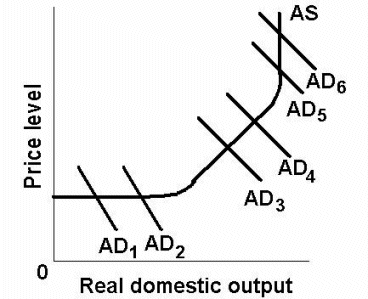
1. Easy monetary policy may be inflationary if
initial equilibrium is at or near full-employment. (AD3 to
AD4)
2. If economy is below full-employment, easy
monetary policy can shift aggregate demand and GDP toward
full-employment equilibrium. with little effect on inflation
(AD1 to AD2)
3. A tight monetary policy can reduce inflation with
little effect on unemployment if economy is near or above
full-employment (AD6 to AD5)
4. A tight monetary policy can make unemployment worse in
a recession. (AD2 to AD1)
B. Strengths of Monetary Policy
1. It is speedier and more flexible than fiscal
policy since the Fed can buy and sell securities daily.
2. It is less political. Fed Board members are isolated
from political pressure, since they serve 14-year terms, and
policy changes are more subtle and not noticed as much as
fiscal policy changes. It is easier to make good, but unpopular
decisions.
C. Focus on the Federal Funds Rate.
1. Currently the Fed communicates changes in
monetary policy through changes in its target for the Federal
funds rate.
2. Definition
- The Fed Funds rate is the interest rate that banks
pay other banks for overnight loans
- some banks may have ER left over at the end of the
day on reserve at the Fed
- other banks may not have enough reserves to meet
their required reserves
3. The Fed does not set either the Federal funds rate or
the prime rate; each is established by the interaction of
lenders and borrowers, but rates generally follow the Fed funds
rate.
4. The Fed acts through open market operations, selling
bonds to raise interest rates and buying bonds to lower
interest rates
D. Recent monetary policy.
1. Easy money policy in the early 1990s helped
produce a recovery from the 1990-1991 recession and the
expansion that lasted until 2001.
2. Tightening in 1994, 1995, and 1997 helped ease
inflationary pressure during the expansion.
2. To counter the recession that began in March 2001, the
Fed pursued an easy money policy that saw the prime interest
rate fall from 9.5 percent at the end of 2000 to 4.25 percent
in December 2002.
4. The Fed has been praised for helping the U.S. economy
maintain simultaneously full employment, price stability, and
economic growth for over four years.
5. They have also received credit for swift and strong
responses to the September 11, 2001, terrorist attacks,
significant declines in the stock market
E. Problems and Complications
1. Recognition and operational lags impair the
Fed's ability to quickly recognize the need for policy change
and to affect that change in a timely fashion.
- Although policy changes can be implemented rapidly
(short administrative lag), there is a lag of at least 3 to
6 months before the changes will have their full
impact.
- Lags:
1. RECOGNITION LAG is the
elapsed time between the beginning of recession or inflation
and awareness of this occurrence.
2. ADMINISTRATIVE LAG is
the difficulty in changing policy once the problem has been
recognized.
3. OPERATIONAL LAG is the
time elapsed between change in policy and its impact on the
economy. stimulating the economy from
recession.
2. CYCLICAL ASYMMETRY may exist: a tight monetary policy
works effectively to brake inflation, but an easy monetary
policy is not always as effective in
- Japan's ineffective easy money policy illustrates the
potential inability of monetary policy to bring an economy
out of recession. While pulling on a string (tight money
policy) is likely to move the attached object to its desired
destination, pushing on a string is not.
3. CHANGES IN VELOCITY: The velocity of money (number of
times the average dollar is spent in a year) may be
unpredictable, especially in the short run and can offset the
desired impact of changes in money supply. Tight money policy
may cause people to spend faster; velocity rises.
4. The IMPACT ON INVESTMENT may be less than
traditionally thought. Japan provides a case example. Despite
interest rates of zero, investment spending remained low during
the recession.
Also see: http://money.cnn.com/2003/06/11/news/economy/borrowing_slump/index.htm
F. Currently the Fed communicates changes in monetary policy
through changes in its target for the Federal funds rate. (Key
Question 5)
1. The Fed does not set either the Federal funds rate
or the prime rate; each is established by the interaction of
lenders and borrowers, but rates generally follow the Fed funds
rate.
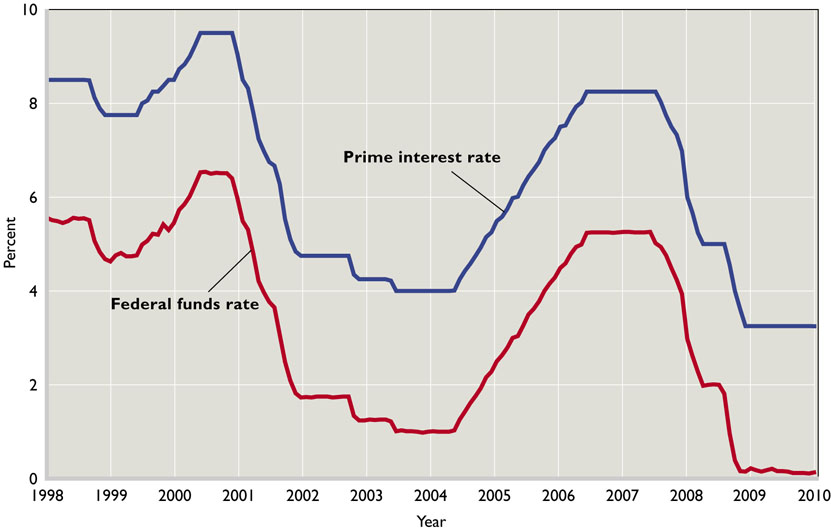
2. The Fed acts through open market operations, selling
bonds to raise interest rates and buying bonds to lower
interest rates.
II. What Causes Macro Instability such as Great
Depression, Recessions, Inflationary Periods?
A. Mainstream View: This term is used to characterize
the prevailing perspective of most economists.
1. Mainstream macroeconomics is Keynesian-based,
and focuses on aggregate demand and its components. C(a) + I(g)
+ X(n) + G = GDP (Aggregate expenditures) = (real output)
2. Any change in one of the spending components in the
aggregate expenditure equation shifts the aggregate demand
curve. This, in turn, changes equilibrium real output, the
price level or both.
a. Investment spending is particularly subject
to variation.
b. Instability can also arise from the supply side.
Artificial supply restriction, wars, or increased costs of
production can decrease supply, destabilizing the economy by
simultaneously causing cost-push inflation and
recession.
B. Monetarist View: This label is applied to a modern form
of classical economics.
1. Money supply is the focus of monetarist
theory.
2. Monetarism argues that the price and wage flexibility
provided by competitive markets cause fluctuations in product
and resource prices, rather than output and employment.
3. Therefore, a competitive market system would provide
substantial macroeconomic stability if there were no government
interference in the economy.
a .It is government that has caused downward
inflexibility through the minimum wage law, pro union
legislation, and guaranteed prices for some products as in
agriculture.
b. Monetarists say that government also contributes to
the economy's business cycles through clumsy, mistaken,
monetary policies.
4. The fundamental equation of monetarism is the equation
of exchange. MV = PQ
a. The left side, MV, represents the total
amount spent [M, the money supply x V, the velocity of
money, (the number of times per year the average dollar is
spent on final goods and services)]
b. The right side, PQ, equals the nation's nominal GDP
[P is the price level or more specifically, the average
price at which each unit of output is sold x Q is the
physical volume of all goods and services produced (real
output)].
c. Monetarists say that velocity, V, is stable, meaning
that the factors altering velocity change gradually and
predictably. People and firms have a stable pattern to holding
money.
d. If velocity is stable, the equation of exchange
suggests there is a predictable relationship between the money
supply and nominal GDP (PxQ).
5. Monetarists say that inappropriate monetary policy is
the single most important cause of macroeconomic instability.
An increase in money supply will directly increase aggregate
demand, causing inflation during periods of
full-employment.
6. Mainstream economists view instability of investment
as the main cause of the economy's instability. They see
monetary policy as a stabilizing factor since it can adjust
interest rates to keep investment and aggregate demand
stable.
C. Consider This…Too Much Money?
1. Mainstream view argues the recession of 2007 - 2008
was caused by AD shocks due to the financial crisis which
decreased investment and consumption spending.
2. Monetarists argue the recession was caused by too much
money which contributed to low interest rates and led to the
housing bubble. The bursting of the housing bubble decreased
AD.
3. Most economists agree that the housing bubble led to the
recession, but many factors contributed to the housing bubble like
loose monetary policy, foreign savings into the U.S., "pass the
risk" lending practices, etc.
III. Does the Economy "Self-Correct"?
A. New Classical View of Self-Correction
1. Monetarist and rational expectation economists
believe that the economy has automatic, internal mechanisms for
self correction.
2. the adjustment process, which retains full employment
output according to this view.
3. The disagreement among new classical economists is
over the speed of the adjustment process.
a. Monetarists usually hold the adaptive
expectations view of gradual change. The supply curve shifts
may take 2 or 3 years or longer.
b. Rational expectations theory (RET) holds that
people anticipate some future outcomes before they occur,
making change very quick, even instantaneous.
i. Where there is adequate information,
people's beliefs about future outcomes accurately reflect
the likelihood that those outcomes will occur.
ii. RET assumes that new information about events
with known outcomes will be assimilated quickly.
4. In RET unanticipated price level changes do cause
temporary changes in real output. Firms mistakenly adjust their
production levels in response to what they perceive to be a
relative price change in their product alone. Any change in GDP
is corrected as prices are flexible and firms readjust output
to its previous level.
5. In RET fully anticipated price level changes do not
change real output, even for short periods. Firms are able to
maintain profit and production levels.
B. Mainstream View of Self Correction
1. There is ample evidence that many prices and
wages are inflexible downward for long periods of time.
However, some aspects of RET have been incorporated into the
more rigorous model of the mainstream.
2. the adjustment process along a horizontal aggregate
supply curve.
3. Downward wage inflexibility may occur because firms
are unable to cut wages due to contracts and the legal minimum
wage. Firms may not want to reduce wages if they fear problems
with morale effort, and efficiency.
4. An efficiency wage is one that minimizes the firm's
labor cost per unit of output. Firms may discover that paying
higher than market wages lowers wage cost per unit of output.
a. Workers have an incentive to retain an above
market wage job and may put forth greater work effort.
b. Lower supervision costs prevail if workers have
more incentive to work hard.
c. An above market wage reduces job turnover.
5. Some economists believe wages don't fall easily
because already employed workers (insiders) keep their jobs
even though unemployed outsiders might accept lower pay.
Employers prefer a stable work force.
IV. Rules or Discretion?
A. Monetarists and other new classical economists believe that
policy rules would reduce instability in the economy.
1. A monetary rule would direct the Fed to
expand the money supply each year at the same annual rate as
the typical growth of GDP.
a. The rule would tie increases in the money
supply to the typical rightward shift of long run aggregate
supply, and ensure that aggregate demand shifts rightward
along with it.
b. A monetary rule, then, would promote steady growth
of real output along with price stability.
2. A few economists favor a constitutional amendment to
require the federal government to balance its budget
annually.
a. Others simply suggest that government be
"passive" in its fiscal policy and not intentionally create
budget deficits of surpluses.
b. Monetarists and new classical economists believe
that fiscal policy is ineffective. Expansionary policy is
bad because it crowds out private investment.
c. RET economists reject discretionary fiscal policy
for the same reason they reject active monetary policy. They
don't believe it works because the effects are fully
anticipated by private sector.
B. Mainstream economists defend discretionary stabilization
policy.
1. In supporting discretionary monetary policy,
mainstream economists argue that the velocity of money is more
variable and unpredictable, in short run monetary policy can
help offset changes in AD than monetarists contend.
2. Mainstream economists oppose requirements to balance
the budget annually because it would require actions that would
intensify the business cycle, such as raising taxes and cutting
spending during recession and the opposite during booms. They
support discretionary fiscal policy to combat recession or
inflation even if it causes a deficit or surplus
budget.
C. The U.S. economy has been about one third more stable
since 1946 than in earlier periods. Discretionary fiscal and
monetary policies were used during this period and not before.
This makes a strong case for its success.
D. A summary of alternative views presents the central ideas
and policy implications of four main macroeconomic theories:
Mainstream macroeconomics, monetarism, rational expectations
theory and supply side economics. (See Table 36.1)
E. CONSIDER THIS … On the Road Again
Keynesian Abba Lerner compared the economy to a car without
a steering wheel, and that the prudent addition and use of a
steering wheel (discretionary fiscal and monetary policy) would
stabilize the macroeconomy. Monetarist Milton Friedman argued that
the steering wheel already exists, and that discretionary use of
monetary policy by the Fed keeps jerking on it, causing the car
(the macroeconomy) to swerve. If the Fed would just hold the
steering wheel steady, the macroeconomy would be stable.
|
OPTIONAL
G. Monetary policy and the international
economy:
1. Net export effect occurs when foreign
financial investors respond to a change in interest
rates.
a. Tight monetary policy and higher
interest rates
1) lead to appreciation of dollar value
in foreign exchange markets;
2) When dollar appreciates, American goods
become more costly to foreigners, and this
lowers demand for U.S. exports, which tends to
lower GDP.
3). This is the desired effect of a tight
money policy.
b. an easy money policy and lower interest
rates
1) leads to depreciation of dollar,
2) greater demand for U.S. exports and higher
GDP.
3). This policy has the desired outcome for
expanding GDP.
2. Summary

3. FP vs. MP and the international
economy
a Expansionary FP:
1) goal to increase AD and reduce
UE
2) net export effect
- gov't borrowing can cause
higher
interest rates, which causes
- greater
demand for the dollar by foreigners, which
causes
- the
DOLLAR to APPRECIATE, which
causes
- US
imports to increase and US exports to
decrease, which
- will
DECREASE AD and
- REDUCES
THE EFFECTIVENESS of the expansionary FP
(SMALLER MULTIPLIER)
b. Easy MP:
1) goal to increase AD and reduce
UE
2) with the international economy
- increasing
the MS causes lower interest rates, which
causes
- less
demand for the dollar by foreigners, which
causes
- the
DOLLAR to DEPRECIATE, which
causes
- US
imports to decrease and US exports to
increase, which
- will
INCREASE AD
- INCREASES
THE EFFECTIVENESS of the easy MP.
|













